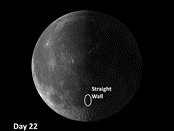The week of September 7 – October 3 takes us from Day 20 to Day 27.
This week we will highlight Rupes Recta, the Straight Wall, viewable on Tuesday, Day 22, after midnight.
 Straight Wall: (Rupes Recta): [SW/M9] Two of the best-known faults on the Moon are Rupes Recta and Rupes Cauchy [Day 4]. They are fascinating to explore, and they share remarkably similar neighborhoods. Both features are paralleled by a nearby rille, and in each case, an intervening small crater separates the rille and the fault.
Straight Wall: (Rupes Recta): [SW/M9] Two of the best-known faults on the Moon are Rupes Recta and Rupes Cauchy [Day 4]. They are fascinating to explore, and they share remarkably similar neighborhoods. Both features are paralleled by a nearby rille, and in each case, an intervening small crater separates the rille and the fault.
 Straight Wall is the showpiece lunar fault line and can be seen clearly in the smallest telescopes. It is 70 miles long and 1,300 feet high. If you view it either in the early morning on Day 8, or at lunar sunset around Day 22, you will see clear evidence that Straight Wall is an enormous fault line where the terrain to its west has fallen away. In the morning, the rising sun casts a thick black shadow over the lava plain to the west. At sunset two weeks later, the exposed slope of the fault is brightly illuminated.
Straight Wall is the showpiece lunar fault line and can be seen clearly in the smallest telescopes. It is 70 miles long and 1,300 feet high. If you view it either in the early morning on Day 8, or at lunar sunset around Day 22, you will see clear evidence that Straight Wall is an enormous fault line where the terrain to its west has fallen away. In the morning, the rising sun casts a thick black shadow over the lava plain to the west. At sunset two weeks later, the exposed slope of the fault is brightly illuminated.
At its south end, Straight Wall terminates in what looks like a small arc of mountains. The effect of the ensemble makes Straight Wall look remarkably like a sword with handle and hilt. This arc of mountains is actually the remains of an ancient unnamed crater whose western side, like Straight Wall itself, dropped as a result of faulting. When lava-flows later flooded Mare Nubium they also covered the slumped western portion of this crater.
======================
It is highly recommended that you get a copy of Sky and Telescope’s Field Map of the Moon, the very finest Moon map available for use at the telescope. It is available for $10.95 at www.skyandtelescope.com and on Amazon. All features mentioned in this blog will be keyed to the grid on the Field Map and will look like this: Plato: [NW/D9]
Credits:
Courtesy of Gray Photography of Corpus Christi, Texas
Lunar photos: NASA / USGS / BMDO / LROC / ASU / DLR / LOLA / Moon Globe. Used by permission
- Rupes Cauchy: A Best Known Fault on the Moon - July 22, 2024
- Moon Crater Schickard – Crater Floor has Stripes - July 15, 2024
- Moon Craters Langrenus and Vandelinus - July 8, 2024